全站搜索
Search the entire website
Search the entire website
Seeing a flash of yellow in a rock is exciting, but is it real gold or just “Fool’s Gold”? This is the classic Pyrite vs. Gold dilemma that has frustrated prospectors for centuries. As experts in mining machinery at ZONEDING, we know the difference well. In this guide, we will share the simple, practical field tests that anyone can use to identify real gold. You won’t need any fancy equipment, just the right knowledge to tell the treasure from the trickster.
Pyrite is an iron sulfide mineral with the chemical formula FeS₂. It is one of the most common minerals on Earth. The reason it earns the name “Fool’s Gold” is its deceptive appearance. It has a pale, brassy-yellow color and a bright metallic luster that can look very similar to gold to the untrained eye.
Pyrite often forms in well-defined, sharp-edged crystals, such as perfect cubes, octahedrons, or multi-faced shapes called pyritohedrons. You’ll often see these perfect metallic cubes embedded in other rocks. While it is not valuable as a precious metal, it is sometimes as a source of sulfur for producing sulfuric acid. But if you are prospecting for wealth, finding a pocket of pyrite is a classic letdown.
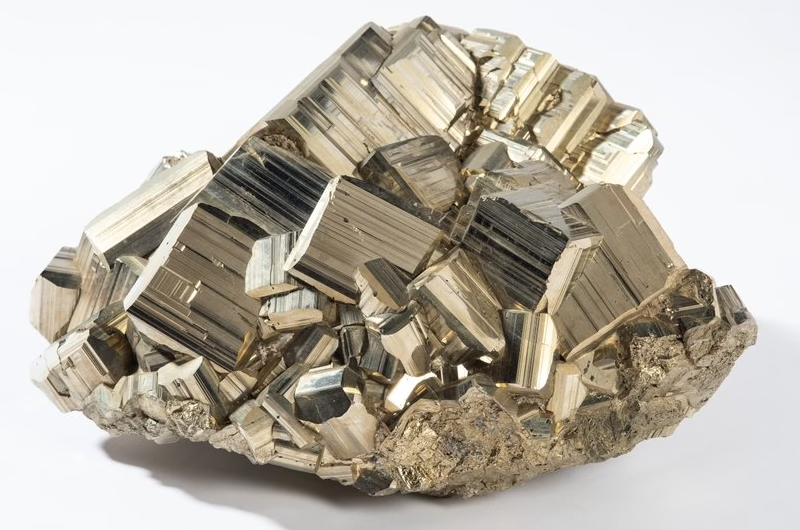

Gold is a chemical element with the symbol Au. It is a dense, soft, shiny, and incredibly valuable precious metal. Unlike pyrite, which is a compound of iron and sulfur, gold is a pure element in its native form.
What does raw gold look like? In nature, it rarely forms sharp crystals. It is usually as irregular nuggets, tiny flakes scattered through rock, smooth “pickers” in a stream bed, or as branching, vein-like structures running through quartz. It has a deep, rich, buttery yellow color that is unmistakable once you’ve seen it. Gold does not tarnish or rust, so its color remains constant even after thousands of years. Its value comes from its rarity, beauty, and unique physical properties, making it the ultimate prize for any prospector.
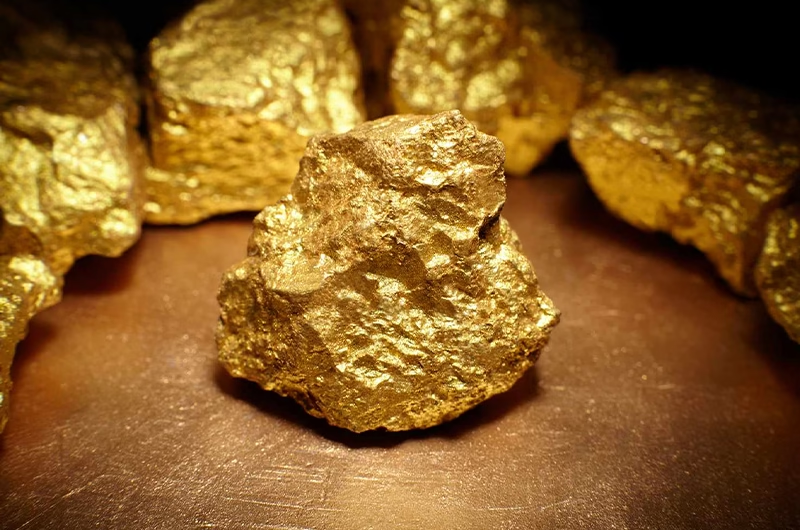
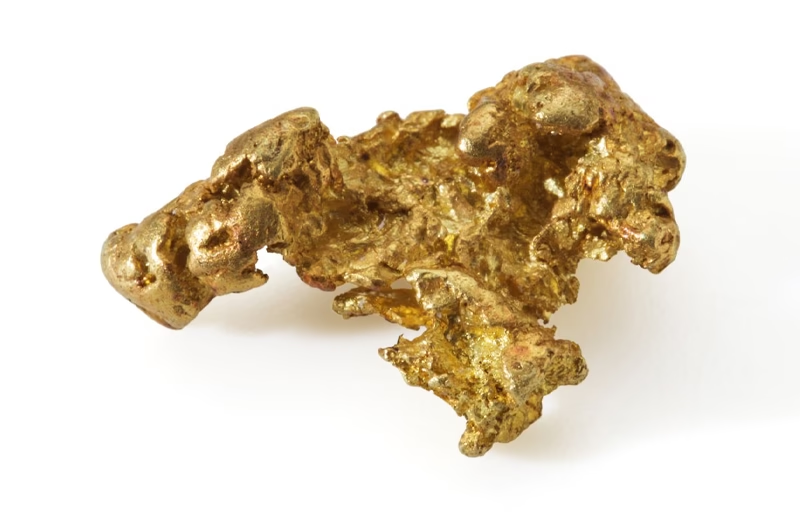
When you place Pyrite vs. Gold side by side and know what to look for, the differences become glaringly obvious. We will break down the key characteristics that will help you master gold identification and never be fooled again.
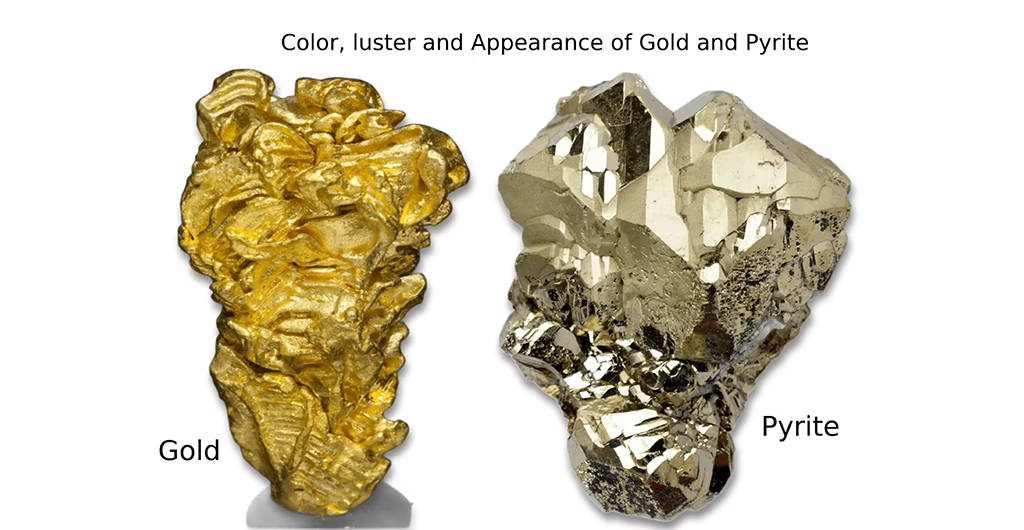
This is the first test, and it relies on careful observation. Gold has a deep, rich, metallic yellow color. Think of it as a soft, warm, buttery yellow. Pyrite has a much paler,brassy-yellow color that can sometimes have a greenish or silvery tint. It has a harsh, cold, reflective shine.
A great way to tell them apart is to observe them in both direct sunlight and in the shade.
This is one of the most reliable and definitive physical tests. Gold is a very soft metal. On the Mohs hardness scale, it ranks between 2.5 and 3. Pyrite, made of iron sulfide, is surprisingly hard and brittle, ranking between 6 and 6.5.
This difference is dramatic and instantly noticeable if you can hold a sample in your hand. Gold is one of the densest materials on Earth, with a specific gravity of 19.3 g/cm³. Pyrite is much less dense, with a specific gravity of around 5 g/cm³.
This means that for two samples of the exact same size, the gold will feel almost four times heavier than the pyrite. This “heft test” is very intuitive. If you hold a suspected nugget and it feels surprisingly light for its size, it is probably pyrite. If it feels unusually heavy, you might have the real thing. This incredible density is the entire principle behind gold panning and sluicing. When you swirl a pan of river gravel, the heavy gold sinks to the bottom while the lighter sand, gravel, and pyrite are washed away.
The streak test for gold is a classic, definitive method used by geologists, and it’s one of the best ways to identify real gold. The “streak” is the color of a mineral’s powder, which reveals its true, internal color. You perform this test by rubbing the mineral firmly across a piece of unglazed ceramic, like the back of a bathroom tile or the bottom of a coffee mug.
Nature builds gold and pyrite in very different ways. This is a key visual clue.
This is a very simple but effective test you can perform. Gold is not magnetic. If you hold a strong magnet up to a piece of pure gold, nothing will happen. There will be no attraction at all. Pyrite is an iron sulfide, and because it contains iron, it can sometimes be weakly magnetic. While not all pyrite will stick to a magnet, some samples will show a slight pull. If your sample reacts to a magnet at all, you can be sure it is not gold.
This test examines how a mineral behaves under pressure. It is another definitive difference.
Knowing the typical environment for each mineral can help you manage your expectations.
Gold is rare. It is typically found in two main types of deposits:
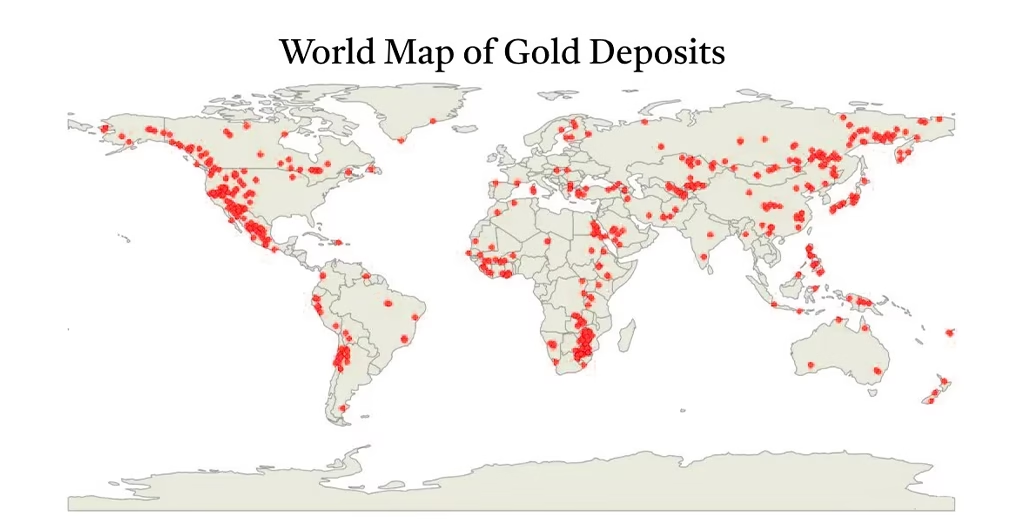
Pyrite is everywhere. It is found in huge quantities all over the world and in all three major rock types:
Here is a simple table to summarize the key differences between pyrite and gold.
| Test | Real Gold (Au) | Fool’s Gold (Pyrite – FeS₂) |
|---|---|---|
| Color | Deep, buttery yellow. It glows in the shade. | Pale, brassy yellow. It glitters, dark in shade. |
| Hardness | Very soft (2.5-3). Scratched by a steel nail. | Very hard (6-6.5). Scratches steel. |
| Weight/Density | Extremely heavy for its size (19.3 g/cm³). | Much lighter for its size (5 g/cm³). |
| Streak | Leaves a true golden-yellow streak. | Leaves a greenish-black streak. |
| Shape | Irregular nuggets, flakes, and smooth grains. | Forms sharp, perfect cubes and other crystals. |
| Response to Hit | Dents or flattens (malleable). | Shatters or turns to powder (brittle). |
Choosing the right impact crusher for your operation is a critical decision that affects your product quality, operational costs, and overall profitability. The two main types, the Horizontal Shaft Impactor (HSI) and the Vertical Shaft Impactor...
View detailsThis guide explains Mineral Processing. It covers how valuable materials are obtained from the Earth. If ever wondered where the metal in a car originates, this guide provides the answer. It aims to make Ore Processing easy to understand. Readers...
View detailsWater is one of the most valuable resources at any mine site. Managing it effectively is key to profitability and environmental responsibility. Mining Thickeners are the workhorses that make this possible. They are large, circular tanks designed ...
View detailsGold extraction is the industrial process of separating pure gold from the rock, or ore, that holds it captive. At my company, ZONEDING, we have been building the specialized machinery for this complex process since our founding in 1990. You mus...
View details